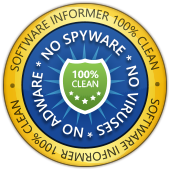
SoftRock Ensemble Configuration Tool.



|
SoftRock Ensemble Configuration Tool. |


|
The ConFiG SoftRock tool (CFGSR.exe) can be used to configure the SoftRock USB Si570 firmware. This firmware is the official supplied firmware in the SoftRock SDR kits of Tony Parks that are using a Si570 chip from Silicon Laboratories (SiLabs).
SiLabs did create a new version of the Si570 chip that can be ordered with a 7ppm temperature stability. The only disadvantage of the new chip version is the change of internal registers, the firmware need to know if it is a old or new chip version, my firmware (V15.15) will do a auto-detect to check the chip version.
Beside this CFGSR program there is also a ExtIO_Si570.dll file to be used with Winrad and clones like the HDSDR or others. The CFGSR and ExtIO_Si570 are now based on the same source files and will function (almost) the same. With the installation of this package you will also get the ExtIO on your system, you must copy the file to the Winrad executable directory.
The installation can be done by running the Microsoft Installer setup file that will download the correct
msi file.
That will create a directory /CFGSR/ in the Program files directory, and add a menu entry in start programs.
The programs are signed with a certificate of the Amateur Radio Certificate Authority.


The general screen shows the version number of the connected firmware also the USB manufacture / product and version
number read from the firmware is shown.

The USB screen will show in the listbox the libUSB-win32 devices that are connected to the PC.
(If the filter driver is installed all the USB devices will be seen).
By clicking on a device the information is copied to the fields above that are used for selecting
the device that will be connected. A empty field will match any value.
The "Auto connect" switch can be used to connect to every device that confirm the credentials. It will
connect at program startup and on inserting the device in the USB port.

The field's are:

The LO screen will be used for the calculation of VFO frequency. Specifying a frequency in the
SDR software aplications need to be recalculated to a specific Si570 frequency. It all depents on the
hardware configuration of the receiver and maybe the used converters. Bob G8VOI did write some
interesting documents about that.
In all cases the frequency calculation can be done with a (real number) multiply and offset value.
The box "LO: Total" is used to specify with offset and multiply factor is needed. The "LO: DLL" specified
the part of the calculation done in the SDR application software and the "LO: Firmware" specified the
part that is done in the firmware.
The button "Read" and "Write" can be used to read the firmware offset and multiply value's or to write
the changed value's to the firmware.

This screen can be used to set a specified freqency. (use the mouse scroll wheel to change the frequency.)
It will also display the "Set frequency", Freq from the PC to the firmware over the USB. Also the
"Si570 output frequency", real Si570 frequency with possible calculations done.
Also the selected filter from the ABPF will be displayed (if ABPF is enabled).

If the firmware support the "automatic band pass filter" function (ABPF), this screen can be used to change the
filter cross over points. It is only useful when the "Electronically Switched BPF Kit" of Tony is ued.
The function can be switched on / off with the enable button (default ON).
To change a filter cross over point first select the line and press "Edit" or double click the line. After
changing the value's save it to the firmware with the "Save" button. (The change of the Enable button is
direct done in the firmware.)
To reset the internal crystal value to 114.285MHz press "Reset".
The calibration process is limited for the crystal frequency between 112MHz and 117MHz.
Only for the new Mobo kit users.
V1.0 at 04/09/2009: First release.

Calibration can be done in this program by two ways, Calibration A and B.
And to copy the crystal value in Hz press "Ctrl-C" button.

Overview of most of settings in te firmware and Si570.





Download.
V1.1 at 16/09/2009: Microsoft MFC library static linked.
V1.2 at 17/09/2009: Bug fix for old firmwre V1.4 (CFGSR + SRDLL).
V1.3 at 20/10/2009: Bug fix for ABPF Enable.
V2.3 at 14/02/2011: Many changes and for lates firmware versions.
V2.4 at 11/12/2011: Update for the firmware V15.15, new Si570 chip.
V2.5 at 08/04/2012: Simple TX functionality for HDSDR.
V2.6 at 09/05/2012: Small bug-fix Initialize SoftRock bandfilter setting.
The SoftRock Config tool is using a SoftRock DLL (SRDLL.dll) to handle the protocol and the USB interface.
All the firmware commands are available in the SRDLL and the interface to the SoftRock is back to only
a srOpen(...) and srClose() call and for example a srSetFreq(7.040) command.
I expect that if you like to control the SoftRock V9.0 from your application software and don't want to
handle all the USB and interface data formats the dll can be very handy.
The SoftRock Config tool is using this dll for all the communication with the firmware,
only the special list control in the USB tab-blad is using direct USB call's.
I did add a command line example program CMDSR.exe to the distribution so that the usage can easely been seen.
The SRDLL source can also be direct included in your program, like it is done with CFGSR and ExtIO, no extra
DLL need to be handled then.
The dll file and the source is available from this link:
V1.0 at 04/09/2009: First release.
V1.1 at 17/09/2009: Bug fix for old firmwre V1.4.
V2.4 at 10/04/2012: Updated call interface, source from CFGSR, ExtIO_Si570 V2.4
Download source V2.4 SRDLL_V2.4.zip

|
File last modified on Thursday, 13-Mar-2025 13:36:38 CET My BitCoin address: 1MqQWXdaBAmYFNqXnQLd5cxG6KkvLj9LPK |
|